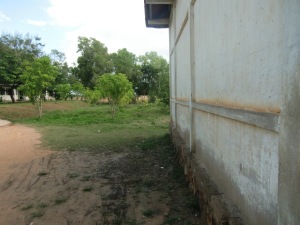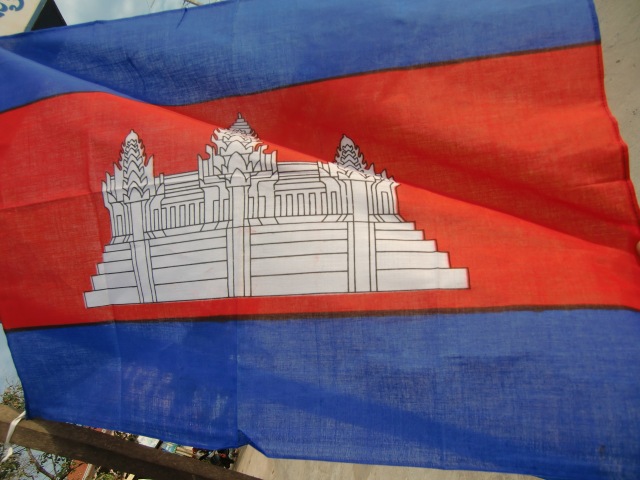Today, I am haunted by history.
School is closed. My host family and nearly everyone else in town are flying the Cambodian flag in front of their houses.
My host mother is taking the day off from her work as a pork seller in the market. She usually works every holiday. But, today is “Victory Over Genocide Day” and she wants to give her full attention to it. She only has to look as far as her left arm to see a scar from the bullets of those who were defeated January 7, 1979.
On that day, Vietnamese forces invaded Cambodia ending the Khmer Rouge’s reign of terror which left more than two million Cambodians dead. That same year, my host mother says she was shot in the arm by a stray bullet from a Khmer Rouge gun near her home in Siem Reap Province.
Everyday I look around and see the beauty of Cambodia. Rice fields surround Puok as far as the eye can see. Lakes, colorful Buddhist wats and ancient temples are abound. It’s hard to imagine the ground I bike on daily was a setting for one of the world’s greatest atrocities.
Mass murders happened all over Siem Reap Province, even in Puok. I did some research to find out just how extensive the horror was in my own backyard.
____________________________________________________________
On the map of Cambodia below, Khmer Rouge killing fields are marked by red dots. (‘Killing fields’ were the areas where Khmer Rouge soldiers executed innocent victims by the dozens, by any means imaginable).
Siem Reap Province is highlighted in lime-green.
The cluster of four killing fields on the left side of Siem Reap Province is Puok. I circled Puok in blue.
 (Map from: Yale Cambodian Genocide Program)
(Map from: Yale Cambodian Genocide Program)
__________________________________________________________
The reality of those red dots isn’t hard to find in Puok today.
For me, the most haunting part of the Khmer Rouge’s former presence in Puok is Building “A” on Puok High School’s campus. You’ve seen Building “A” before. It’s the building I sat in front of during the school’s opening ceremony in October 2010.
 Building “A” is the oldest classroom building on campus and today it’s made up of Eleventh Grade classrooms. I walk by the building daily and see students studying there.
Building “A” is the oldest classroom building on campus and today it’s made up of Eleventh Grade classrooms. I walk by the building daily and see students studying there.
 When the Khmer Rouge wiped out education in Cambodia, Building “A” served another purpose.
When the Khmer Rouge wiped out education in Cambodia, Building “A” served another purpose.
My Cambodian co-teacher told me that during the Khmer Rouge years Building “A” became a torture prison.
 I took a look inside. Next to students’ desks, teachers’ desks and whiteboards, you can still see the holes where, I’m told, chains and possibly other devices were hooked to the walls.
I took a look inside. Next to students’ desks, teachers’ desks and whiteboards, you can still see the holes where, I’m told, chains and possibly other devices were hooked to the walls.




 My co-teacher also tells me that during the Khmer Rouge years, a field that borders Puok High School’s campus served as a killing field. He says countless people were executed there, in a field I can see through the window while I’m teaching.
My co-teacher also tells me that during the Khmer Rouge years, a field that borders Puok High School’s campus served as a killing field. He says countless people were executed there, in a field I can see through the window while I’m teaching.
 The Khmer Rouge Trial Web Portal sheds more painful, but important light on what Siem Reap Province experienced. Every bit of it is still shocking:
The Khmer Rouge Trial Web Portal sheds more painful, but important light on what Siem Reap Province experienced. Every bit of it is still shocking:
_______________________________________________________________
“The province was known as Zone 106 or the Northwest Zone during the Khmer Rouge time. Thousands of Cambodians were forcibly moved to agricultural camps in the Siem Reap countryside when the Khmer Rouge evacuated Phnom Penh and Siem Reap town in 1975. A Documentation Center of Cambodia initiative has mapped hundreds of mass graves in Siem Reap full of the anonymous remains of tens of thousands of Khmer Rouge victims.
“According to survivors in the area, the Khmer Rouge would kill whole families at once and bury them in these pits in an attempt to erase the family from existence. Land mines and cluster bombs from decades of war still plague the province and victims of these indiscriminate weapons are easy to find. Areas of the province continued to be dangerous for travel until 1998 due to Khmer Rouge soldiers and bandits.
“One middle-aged man pointed from where we were sitting in the village pagoda across the rutted dirt road to a rice paddy. ‘Just over there,’ he said, ‘they lined up twelve people and shot them all in the back of their heads.’ Another man described Khmer Rouge cadres killing children by throwing them in the air and bayoneting them.”
_________________________________________________________________
January 7, 2011 is a day being celebrated by my host family and neighbors. Many people in Siem Reap Province view January 7 as the day a nightmare ended. I’ve heard it called, “Cambodia’s second birth”.
There’s a carnival in town to mark the holiday. My host family exchanged gifts. And, this morning I went to a ceremony with other teachers and students to hear about the future of Cambodia’s environment, economy and education system. At the ceremony I sat under seven Cambodian flags and next to seven monks.
Despite the discomfort of all the details above, I think history is important to reflect on for me, as a new member of this community.
My neighbors tell me that reflecting on this bloody history, but remaining hopeful is somewhat easier these days because the City of Siem Reap has returned to its former glory. And people in Puok are well on their way to creating a better future.



It is great that you are learning about history that has affected your surroundings. It is important in order to better understand the people there, as well. Thanks for sharing this history with us. Celebrate this important holiday.
Love you!
This is hard to read all in one setting. You are with amazing people right now. It is wonderful that you have such an interest in the lives and history of these people. Celebrate with them. You are truly an important part of their lives. I can feel your love for them, and your desire to help them as I read. I feel blessed just knowing you and learning from what you are doing.
Thank you for sharing such important history with us. I love the fact that they’ve taken such tragedy and found a way to celebrate the positive and look towards the future. Enjoy the celebration!
Thanks for sharing the history. It is so incredible to think that all happened not so long ago. We don’t know how lucky we are to live in the country that we do. It is so wonderful that you are helping change the lives of those your are teaching and they will continue to change their country. All our love, hugs and kisses. Kaki
I had read of these horrific events in the past. Reading your words today, Travis bring tears to my eyes yet again. So many beautiful people wiped from the earth. Thank you for sharing and including the fact that these wonderful people have the courage and bravey to, celebrate, for a better tomorrow.
Thank you David. And thanks for reading. I miss you all in Kentucky. Tell the folks in Boyle County I said hello.